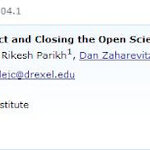Science & Society

The future of biolectronics - being able to diagnose diseases, detect poisons and monitor health instantly - may still seem far away, but it may be closer than you think.
Researchers understand what biochemical reactors they need to monitor and they know which microelectronics they would need to use. They have just been unable to combine them because measuring the ions in receptors within cell membranes destroyed the cells being measured.
A team at the Max Planck Institute say they have solved the problem and describe the coupling of a receptor to a silicon chip by means of a cell–transistor…

Scientists at the Alaska Stable Isotope Facility can tell you whether marijuana came from Mexico or the Matanuska Valley. Soon they'll even be able to tell you whether it was grown indoors or out.
A few more years and enough samples and they hope to have something even more precise: an elemental fingerprint that could tell police where and under what conditions a sample of marijuana was grown.
"There are scientists already doing this for drugs like heroin and cocaine," said Matthew Wooller, Alaska Stable Isotope Facility director. "The potential is there for being able to do this for…

Following up on my initial comments, my first two posts in Nature Precedings have appeared.
Most people have been posting Powerpoint presentations so I started there with a recent presentation at the American Chemical Society about Open Notebook Science.
Open Notebook Science Using Blogs and Wikis (doi:10.1038/npre.2007.39.1)
Next, I posted an update on the CombiUgi project by basically combining two blog posts (one and two).
It took a lot longer to do this than I expected, experimenting with the format and trying to make it fairly self-contained. I ended up using Powerpoint, which I like…
A team of LLNL researchers has conceptually proven that a three-in-one machine, or “universal point detection system,” that can detect explosive, chemical and biological agents all at the same time, can be achieved, said George Farquar, a postdoctoral fellow and physical chemist at the LLNL’s Glenn T. Seaborg Institute.
Audrey Martin adjusts the lens stack of SPAMS. Martin, who worked at LLNL for 15 weeks last summer as a Department of Homeland Security (DHS) Fellow, is the first DHS intern hired into the Laboratory as a full-time student employee.
The team’s latest advance uses its mass…

If you've ever thought about running a public company, Sarbanes-Oxley is something you probably dread. Commonly dubbed "The Enron Law", it requires enormous oversight paperwork with the consequence that Chairmen, CEOs and Directors can go to jail if they violate it. A new University of Georgia study finds that the 2002 law has altered the makeup of corporate boards, making them larger and more independent and also had the unintended effect of increasing director pay - by more than 50 percent.
CEO pay as well. If you can go to jail for doing a job, be it Director or CEO, you demand more…

The unique cooperation model used in the political field by the countries around the Baltic Sea needs to be extended to the public-private sector in order to increase the competitiveness and attractiveness of the Baltic Sea Region. This was one of the main conclusions reached by the leading representatives from business, government and research within the ICT and Life-Science at the seminar "Talents on Top of Europe" at the Nordic Embassies in Berlin today.
With the knowledge society demanding an ever increasingly skilled workforce and a steady stream of talented young people, the seminar,…

Egon has just posted about Nature Precedings, which looks like a no-brainer as an additional publication outlet for UsefulChem. I've requested an account and we'll see how it works.
In my view, producing knowledge in a Science 2.0 world is about communicating through redundancy, making it easy to prove who-knew-what-when. That is difficult to do with the traditional scientific publication system of giving away copyright. (Not impossible, because concepts and results can be rewritten using different words, but still difficult).
This should be interesting. Here is a description of Nature…

What do glowing veggies have to do with a career in science" It just so happens that electrified pickles swimming in metal ions are one example of the type of undergraduate chemistry class demonstration that helps make a future in science a bright possibility, rather than a total turn-off, for many students.
In a commentary in this month’s Nature Chemical Biology, Brandeis University and Howard Hughes Medical Institute (HHMI) Professor Irving Epstein outlines a gathering storm clouding the future of U.S. science and prescribes a series of strategies to help avert a looming national crisis.…

Millions of people the world over suffer today from obesity, yet there is no “magic bullet” that has yet provided a universally accepted solution. However, a young researcher at the Hebrew University of Jerusalem feels he has come up with a practical weight loss solution for the obese person without his having to feel hungry.
For this development, Yaniv Linde, a 32-year-old Ph.D. student of Prof. Chaim Gilon in the Department of Organic Chemistry at the Hebrew University, has been named a first place winner of a Kaye Innovation Award, which was presented today (June 6) during the 70th…

This has been a productive week with setting up Drexel Island on Second Life. We have settled on a pod tree structure to house departments and faculty in the College of Arts and Sciences. Eloise helped with the pods and Beth and I selected most of the content. The chemistry pod has a list of recent student awards, some images of our equipment and a 3D Bunsen burner and molecule.
The faculty pods are arranged like leaves hovering above the departmental base pods. There are plenty of spaces that we'll populate as we get more faculty involved. For my pod, I have my picture, a link to my organic…